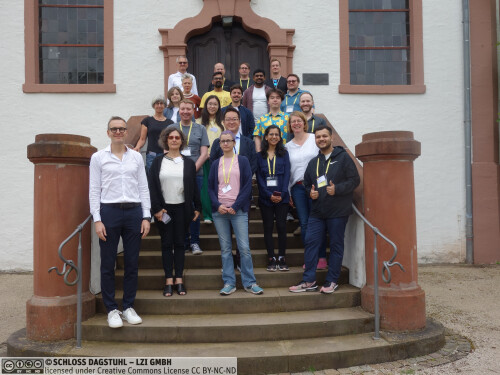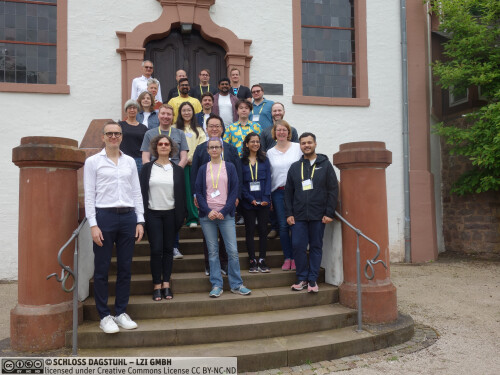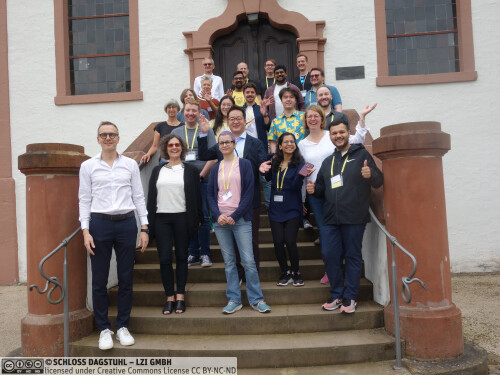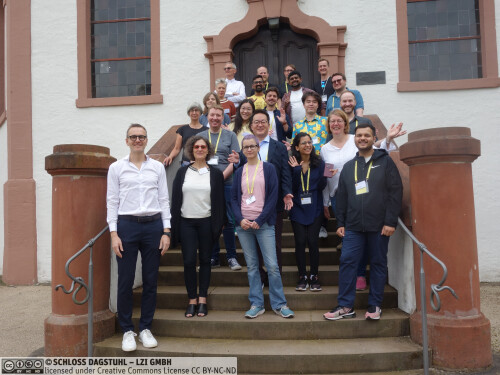Dagstuhl-Seminar 24232
Designing Computers’ Control Over Our Bodies
( 02. Jun – 07. Jun, 2024 )
Permalink
Organisatoren
- Nadia Bianchi-Berthouze (University College London, GB)
- Mar Gonzalez-Franco (Google - Seattle, US)
- Florian 'Floyd' Mueller (Monash University - Clayton, AU)
- Misha Sra (University of California - Santa Barbara, US)
Kontakt
- Andreas Dolzmann (für wissenschaftliche Fragen)
- Christina Schwarz (für administrative Fragen)
The Dagstuhl Seminar 24232, titled “Designing Computers’ Control Over Our Bodies”, was held from June 2 to June 7, 2024, at Schloss Dagstuhl – Leibniz-Zentrum für Informatik, Germany. This seminar brought together leading experts from diverse fields to explore a new paradigm in human-computer interaction (HCI) where technologies such as electrical muscle stimulation, galvanic vestibular stimulation, and exoskeletons enable computers to exert direct control over the human body [1, 2, 3, 4, 5]. The seminar addressed both the opportunities and challenges of this emerging domain, which extends beyond the traditional model of user-directed interaction to consider reciprocal roles where machines also assert control [3, 6, 7].
Over the course of five days, participants engaged in a variety of activities designed to foster interdisciplinary collaboration and develop a comprehensive understanding of this complex interaction paradigm. The seminar’s objectives included the following:
Identifying Theoretical Gaps. Participants explored the absence of a structured theoretical framework for articulating and evaluating experiences of being controlled by a machine. Discussions focused on such interactions’ ethical, psychological, and physical dimensions, highlighting the need for a multidisciplinary approach to understand and design for these new dynamics [8, 9, 10].
Design Challenges and Opportunities. The seminar investigated the design challenges associated with computational control over the human body, considering both the benefits, such as enhanced safety in autonomous systems and increased mobility, and the concerns, including issues of user agency, consent, and trust [11]. Hands-on sessions enabled participants to prototype and critique design concepts that address these complexities.
Societal Implications. The discussions extended to the societal impact of these technologies, examining potential applications and unintended consequences. Ethical considerations, particularly around the autonomy of users and the transparency of machine actions, were central to these debates [12]. The seminar aimed to outline guidelines for the responsible development and deployment of such technologies in various contexts, from healthcare to entertainment.
Envisioning Future Directions. A key focus of the seminar was envisioning the future landscape of HCI where computational control technologies become more prevalent. Speculative design sessions invited participants to imagine both utopian and dystopian scenarios for the year 2050, facilitating discussions on the potential trajectories of these technologies withand without-AI, and their integration into daily life.
Developing a Research Agenda.The seminar concluded with the development of a research agenda to guide future work in this field. This agenda included key questions to address, potential methodologies for study, and proposals for new theoretical frameworks. Working groups were established to continue collaborative efforts beyond the seminar.
The seminar’s key outcomes included identifying several grand challenges in this emerging field, formulating initial design frameworks, and establishing a network of researchers and practitioners committed to advancing knowledge and practice in computational control technologies. The seminar highlighted the importance of interdisciplinary approaches to understanding and designing for these new interaction paradigms, which blend the digital and physical realms where the computer can control the human body.
The seminar’s findings will contribute to the ongoing discourse on the future of HCI, particularly in areas where control dynamics between humans and machines are increasingly blurred. Moving forward, the insights gained from this event will help shape a more humane technological future, ensuring that innovations in computational control are aligned with ethical and societal values.
References
- Rakesh Patibanda, Chris Hill, Aryan Saini, Xiang Li, Yuzheng Chen, Andrii Matviienko, Jarrod Knibbe, Elise Van Den Hoven, and Florian ‘Floyd’ Mueller. Auto-paizo games: Towards understanding the design of games that aim to unify a player’s physical body and the virtual world. Proceedings of the ACM on Human-Computer Interaction, 7(CHI PLAY):893–918, 2023.
- Pedro Lopes, Sijing You, Lung-Pan Cheng, Sebastian Marwecki, and Patrick Baudisch. Providing haptics to walls & heavy objects in virtual reality by means of electrical muscle stimulation. In Proceedings of the 2017 CHI Conference on Human Factors in Computing Systems, pages 1471–1482, 2017.
- Florian Floyd Mueller, Pedro Lopes, Paul Strohmeier, Wendy Ju, Caitlyn Seim, Martin Weigel, Suranga Nanayakkara, Marianna Obrist, Zhuying Li, Joseph Delfa, Jun Nishida, Elizabeth M. Gerber, Dag Svanaes, Jonathan Grudin, Stefan Greuter, Kai Kunze, Thomas Erickson, Steven Greenspan, Masahiko Inami, Joe Marshall, Harald Reiterer, Katrin Wolf, Jochen Meyer, Thecla Schiphorst, Dakuo Wang, and Pattie Maes. Next steps for humancomputer integration. In Proceedings of the 2020 CHI Conference on Human Factors in Computing Systems, CHI ’20, page 1–15, New York, NY, USA, 2020. Association for Computing Machinery.
- Romain Nith, Yun Ho, and Pedro Lopes. Splitbody: Reducing mental workload while multitasking via muscle stimulation. In Proceedings of the CHI Conference on Human Factors in Computing Systems, CHI ’24, New York, NY, USA, 2024. Association for Computing Machinery.
- Rakesh Patibanda, Elise Van Den Hoven, and Florian ‘Floyd’ Mueller. Towards understanding the design of body-actuated play. In Extended Abstracts of the 2022 Annual Symposium on Computer-Human Interaction in Play, CHI PLAY ’22, page 388–391, New York, NY, USA, November 2022. Association for Computing Machinery.
- Eun-Soo Jung, Suh-Yeon Dong, and Soo-Young Lee. Neural correlates of variations in human trust in human-like machines during non-reciprocal interactions. Scientific Reports, 9, 2019.
- Steve Benford, Richard Ramchurn, Joe Marshall, Max L. Wilson, Matthew Pike, Sarah Martindale, Adrian Hazzard, Chris Greenhalgh, Maria Kallionpää, Paul Tennent, and Brendan Walker. Contesting control: journeys through surrender, self-awareness and looseness of control in embodied interaction. Human–Computer Interaction, 36(5-6):361– 389, 2021.
- Pedro Lopes, Lewis L. Chuang, and Pattie Maes. Physiological i/o. In Extended Abstracts of the 2021 CHI Conference on Human Factors in Computing Systems, CHI EA ’21, New York, NY, USA, 2021. Association for Computing Machinery.
- Rakesh Patibanda, Aryan Saini, Nathalie Overdevest, Maria F. Montoya, Xiang Li, Yuzheng Chen, Shreyas Nisal, Josh Andres, Jarrod Knibbe, Elise van den Hoven, and Florian ‘Floyd’ Mueller. Fused spectatorship: Designing bodily experiences where spectators become players. Proc. ACM Hum.-Comput. Interact., 7(CHI PLAY), oct 2023.
- Rakesh Patibanda, Nathalie Overdevest, Shreyas Nisal, Aryan Saini, Don Samitha Elvitigala, Jarrod Knibbe, Elise Van Den Hoven, and Florian ‘Floyd’ Mueller. Shared bodily fusion: Leveraging inter-body electrical muscle stimulation for social play. In Proceedings of the 2024 ACM Designing Interactive Systems Conference, DIS ’24, page 2088–2106, New York, NY, USA, July 2024. Association for Computing Machinery.
- Florian ‘Floyd’ Mueller, Nathan Semertzidis, Josh Andres, Joe Marshall, Steve Benford, Xiang Li, Louise Matjeka, and Yash Mehta. Toward understanding the design of intertwined human–computer integrations. ACM Trans. Comput.-Hum. Interact., 30(5), sep 2023.
- Saul Greenberg, Sebastian Boring, Jo Vermeulen, and Jakub Dostal. Dark patterns in proxemic interactions: a critical perspective. In Proceedings of the 2014 Conference on Designing Interactive Systems, DIS ’14, page 523–532, New York, NY, USA, 2014. Association for Computing Machinery.
 Nadia Bianchi-Berthouze, Mar Gonzalez-Franco, Florian 'Floyd' Mueller, and Misha Sra
Nadia Bianchi-Berthouze, Mar Gonzalez-Franco, Florian 'Floyd' Mueller, and Misha Sra
Previous human-computer interaction (HCI) paradigms mostly focused on a controller-responder relationship, where the user issued a command to control the computer to execute a task. This paradigm has served computer science well for many decades. However, more recent research steered away from it by not only considering cases where the human being is in control, but also the computer. In particular, more recent research considered human-in-the-loop interactions, where the computer, in return, can also take control. Currently, we are witnessing an emergence of systems in which the computational machine can take control, and in particular, embodied control of the user’s body through technologies such as electrical muscle stimulation, galvanic vestibular stimulation or exoskeletons. In other words, the user’s body is physically controlled by the machine.
Controlling the human body by a computational machine can have many advantages. In the example of the autonomous car, the user is transported to their location faster and more safely than if a human was in control. Similarly, autonomous exoskeletons can provide mobility to paralyzed populations, and even enhance abilities such as strength beyond what is otherwise humanly possible. However, much like earlier technological examples that aimed to take control over the user psychologically, there can be dangers and pitfalls in taking control of the user’s body, leading to widespread fear of the emergence of such technology. Furthermore, despite the growing prevalence of such systems and emerging work on human-computer integration and symbiotic relationships with computational machines, there exists an absence of systematically structured and formally articulated theoretical frameworks for explaining the experiential dynamics afforded by being controlled by a computational machine, and by extension an absence of understanding of how to design computers’ control over our bodies.
This Dagstuhl Seminar will include experts from both academia and industry to bring together leaders from different application domains to work on a coherent approach to understanding the design of user experiences where the machine can take control over the user’s body. The seminar aims to offer a multidisciplinary perspective to engage deeply with the challenges and issues of the topic of the computational machine taking control, to understand better how to move the field forward as a field and how to give back to the community through an enhanced understanding, ultimately helping to produce a more humane technology future.
 Nadia Bianchi-Berthouze, Mar Gonzalez-Franco, Florian 'Floyd' Mueller, and Misha Sra
Nadia Bianchi-Berthouze, Mar Gonzalez-Franco, Florian 'Floyd' Mueller, and Misha Sra
- Nadia Bianchi-Berthouze (University College London, GB) [dblp]
- Susanne Boll (Universität Oldenburg, DE) [dblp]
- Richard James Byrne (Made Tech - Bristol, GB) [dblp]
- Arthur Caetano (University of California - Santa Barbara, US) [dblp]
- Don Samitha Elvitigala (Monash University - Clayton, AU) [dblp]
- Masahiko Inami (University of Tokyo, JP) [dblp]
- Jarrod Knibbe (University of Queensland - Brisbane, AU) [dblp]
- Per Ola Kristensson (University of Cambridge, GB) [dblp]
- Xiang Li (University of Cambridge, GB) [dblp]
- Zhuying Li (Southeast University - Nanjing, CN) [dblp]
- Joe Marshall (University of Nottingham, GB) [dblp]
- Louise Petersen Matjeka (Copenhagen, DK) [dblp]
- Florian 'Floyd' Mueller (Monash University - Clayton, AU) [dblp]
- Minna Nygren (University College London, GB) [dblp]
- Rakesh Patibanda (Monash University - Clayton, AU) [dblp]
- Henning Pohl (Aalborg University, DK) [dblp]
- Sara Price (University College London, GB) [dblp]
- Harald Reiterer (Universität Konstanz, DE) [dblp]
- Aryan Saini (Monash University - Clayton, AU) [dblp]
- Oliver Schneider (University of Waterloo, CA) [dblp]
- Ambika Shahu (TU Wien, AT) [dblp]
- Misha Sra (University of California - Santa Barbara, US) [dblp]
- Jürgen Steimle (Universität des Saarlandes, DE) [dblp]
- Mar Gonzalez-Franco (Google - Seattle, US) [dblp]
Klassifikation
- Human-Computer Interaction
Schlagworte
- control
- human-computer integration
- body
- HCI





 Creative Commons BY 4.0
Creative Commons BY 4.0
